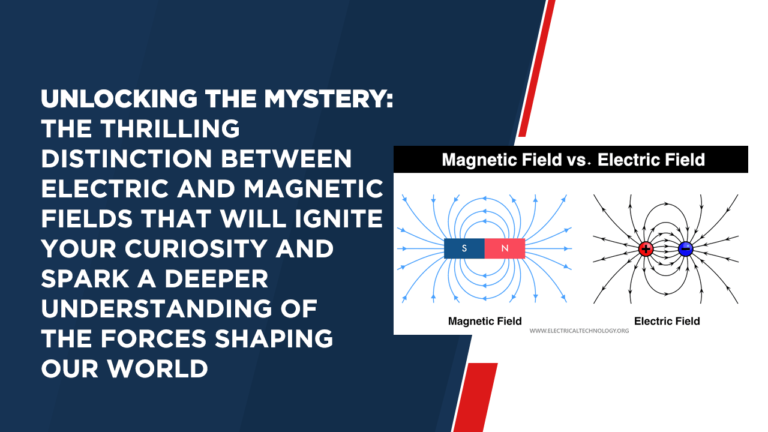Unlocking the Mystery: The Thrilling Distinction Between Electric and Magnetic Fields That Will Ignite Your Curiosity and Spark a Deeper Understanding of the Forces Shaping Our World!
Introduction
Physics is a vast and captivating field that revolves around various forces, including the intriguing interplay between electric and magnetic fields. These two fundamental concepts are intertwined and shape our universe, with the movement of charged particles within their confines playing a crucial role in modern physics. Electric fields are produced by charged particles themselves and influence nearby charges through the forces they generate. On the other hand, magnetic fields are created when moving charges interact with each other, resulting in electromagnetic interactions that give rise to phenomena like light, electricity, and magnetism.
Electric and Magnetic Fields: An Intricate Dance
Electric and magnetic fields are two distinct yet intertwined entities that exert their influence over charged particles. Electric fields emanate from charged particles themselves, producing forces which affect other nearby charges; on the other hand, magnetic fields are created when moving charges exert force against one another – this dynamic interplay between electric and magnetic fields gives rise to electromagnetic interactions that give rise to phenomena like light, electricity and even magnetism.
The Intriguing Relationship between Electric and Magnetic Fields
While electric and magnetic fields are seemingly separate entities, they are deeply connected. This connection was unveiled by James Clerk Maxwell’s groundbreaking equations, collectively known as Maxwell’s equations. These equations elegantly describe how changes in electric fields generate magnetic fields and vice versa, elucidating the profound interdependence of these two forces. This unity laid the foundation for the unification of electricity and magnetism into the unified theory of electromagnetism.
Phase Difference: A Subtle Nuance
When exploring the dynamics of electric and magnetic fields, the concept of phase difference emerges. Phase difference refers to the relative timing of oscillations between these fields. In electromagnetic waves, such as light, the electric and magnetic fields oscillate in sync but are out of phase by a quarter of a wavelength. This intriguing relationship is a testament to the deep-seated connection between electric and magnetic forces and their manifestation in the form of electromagnetic radiation.
Charged Particle’s Intricate Motion
The motion of charged particles in electric and magnetic fields further unravels the profound relationship between these forces. When a charged particle enters an electric field, it experiences a force that propels it along the field lines. In contrast, when a charged particle enters a magnetic field perpendicular to its velocity, it experiences a force perpendicular to both its velocity and the magnetic field direction. This gives rise to circular motion, enabling particle accelerators and shaping our understanding of particle behavior.
Conclusion
The enigmatic bond between electric and magnetic fields, the nuanced phase difference they exhibit, and the mesmerizing dance of charged particles within them collectively form a captivating saga in the realm of physics. As we delve deeper into these concepts, our appreciation for the forces shaping our world grows, fostering curiosity and driving scientific innovation. The electric and magnetic fields stand as a testament to the interconnectedness of the universe and remind us of the awe-inspiring intricacies that continue to define our reality.



